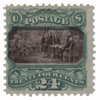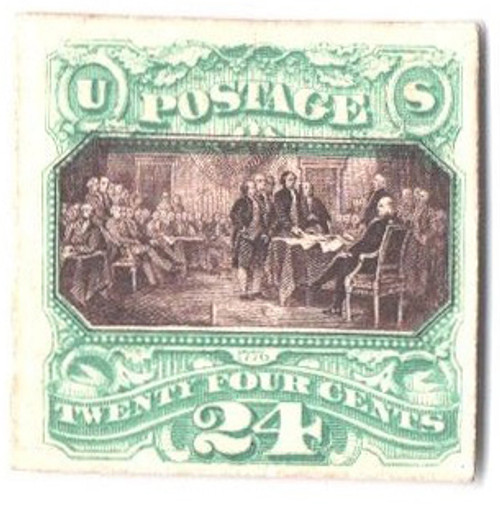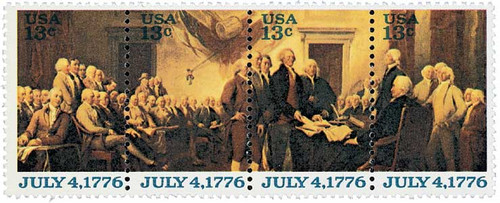
# 120a - 1869 24c Declaration of Independence without grill
U.S. #120a
1869 24¢ Declaration of Independence Pictorial
No Grill
Earliest Known Use: April 7, 1869
Printed by: National Bank Note Company
Method: Flat plate
Watermark: None
Perforation: 12
Color: Green and violet
The 24¢ Pictorial Issue is more commonly known without a grill on the 1875 Re-Issues. There are only 21 certified copies of the 1869 Issue produced without a grill. Less than half of the known examples are completely sound. This stamp is among them.
One of the finest examples of engraving, the center of the stamp consists of a miniature masterpiece. James Smillie engraved 42 persons, and the six principal figures can be recognized under a magnifying glass!
The 1869 Pictorial Series
The appearance of the 1869 Pictorials marked a significant change in U.S. stamp design. For the first time in American postal history, something other than portraits of national leaders was being pictured on a stamp. These were the first U.S. stamps to be printed using two colors.
Printing with two colors required the stamps to be run through the press twice; once, to print the vignette (center design), and then again, to print the frame. Carelessness in merging the two impressions resulted in the rare inverts. Instead of an inverted center, the stamp actually has an inverted frame, since the center design was printed first. The 30¢ Shield and Eagle with inverted flags is the rarest of the 1869 inverts. The least obvious of the three, it was the last to be discovered.
The pictorials were to be produced over a four-year period by the National Bank Note Company. When issued, however, the stamps were unpopular with the public. Within a year after their release, they were withdrawn from sale.
Today, the pictorial issues are the most popular of the 1840 – 1870 Classic Stamps. Because the stamps were only in circulation for a year, they have become increasingly hard to find in both unused and used condition.
U.S. #120a
1869 24¢ Declaration of Independence Pictorial
No Grill
Earliest Known Use: April 7, 1869
Printed by: National Bank Note Company
Method: Flat plate
Watermark: None
Perforation: 12
Color: Green and violet
The 24¢ Pictorial Issue is more commonly known without a grill on the 1875 Re-Issues. There are only 21 certified copies of the 1869 Issue produced without a grill. Less than half of the known examples are completely sound. This stamp is among them.
One of the finest examples of engraving, the center of the stamp consists of a miniature masterpiece. James Smillie engraved 42 persons, and the six principal figures can be recognized under a magnifying glass!
The 1869 Pictorial Series
The appearance of the 1869 Pictorials marked a significant change in U.S. stamp design. For the first time in American postal history, something other than portraits of national leaders was being pictured on a stamp. These were the first U.S. stamps to be printed using two colors.
Printing with two colors required the stamps to be run through the press twice; once, to print the vignette (center design), and then again, to print the frame. Carelessness in merging the two impressions resulted in the rare inverts. Instead of an inverted center, the stamp actually has an inverted frame, since the center design was printed first. The 30¢ Shield and Eagle with inverted flags is the rarest of the 1869 inverts. The least obvious of the three, it was the last to be discovered.
The pictorials were to be produced over a four-year period by the National Bank Note Company. When issued, however, the stamps were unpopular with the public. Within a year after their release, they were withdrawn from sale.
Today, the pictorial issues are the most popular of the 1840 – 1870 Classic Stamps. Because the stamps were only in circulation for a year, they have become increasingly hard to find in both unused and used condition.










